Organizational Change Management: A Comprehensive Analysis Report
VerifiedAdded on 2019/12/03
|13
|5084
|249
Report
AI Summary
This report delves into the multifaceted realm of organizational change management, exploring the application of complexity theory, the impact of resistance to change, and the significance of employee involvement. The report begins by examining how complexity theory can be leveraged by managers to implement strategic changes, emphasizing its role in adapting to external environments and fostering innovation. It then investigates the reasons behind employee resistance to change and how it affects the implementation of planned organizational changes, highlighting the need for proactive management strategies. Furthermore, the report analyzes the crucial role of employee involvement in achieving effective organizational change, underscoring its impact on successful change implementation. Through a comprehensive analysis of these key aspects, the report provides valuable insights into the complexities of organizational change and offers practical guidance for managers seeking to navigate this dynamic landscape. The report also includes a case study of Asda and how they use the concepts discussed in the paper. This paper is contributed by a student and is available on Desklib, a platform providing AI-based study tools for students.
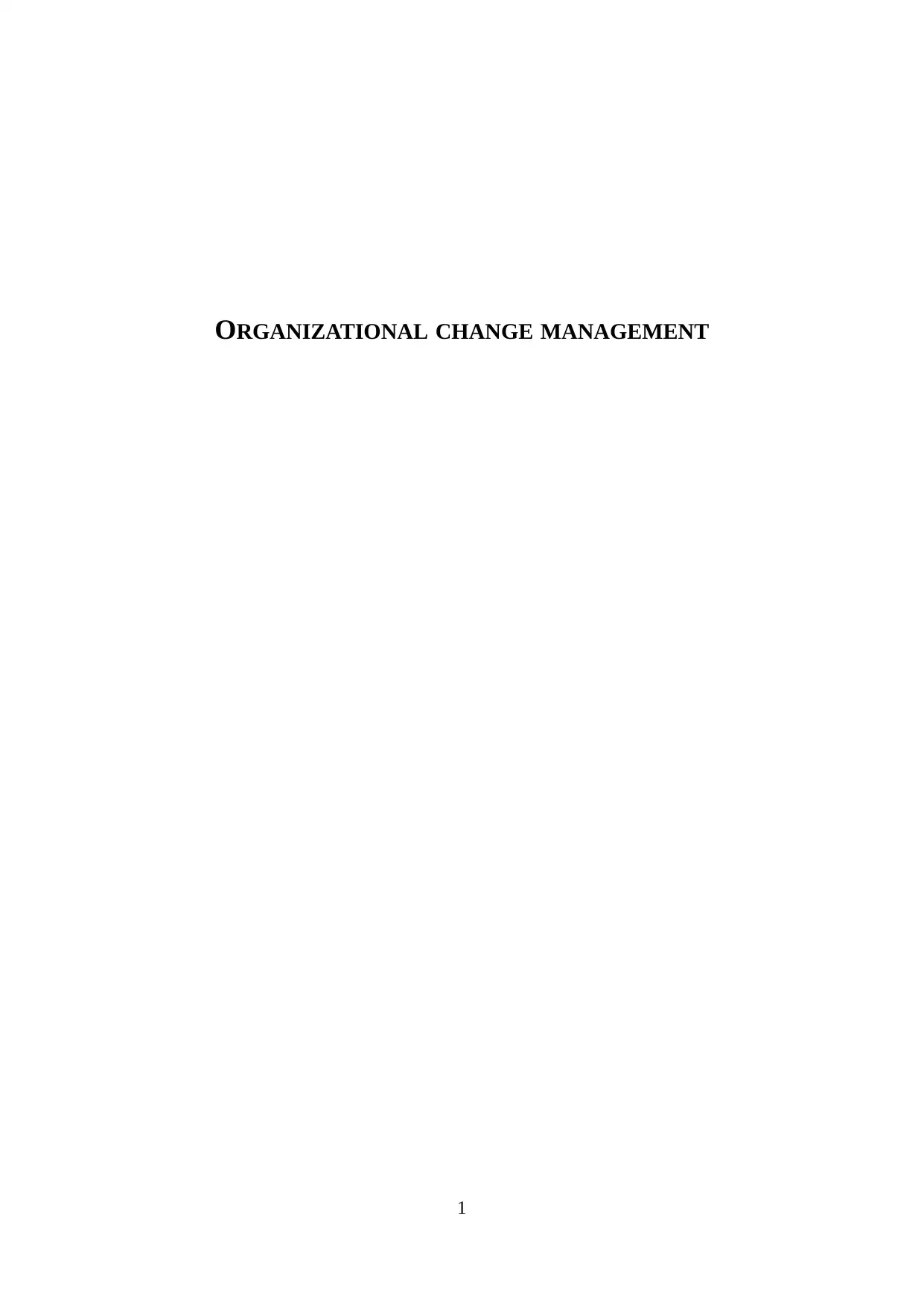
ORGANIZATIONAL CHANGE MANAGEMENT
1
1
Paraphrase This Document
Need a fresh take? Get an instant paraphrase of this document with our AI Paraphraser
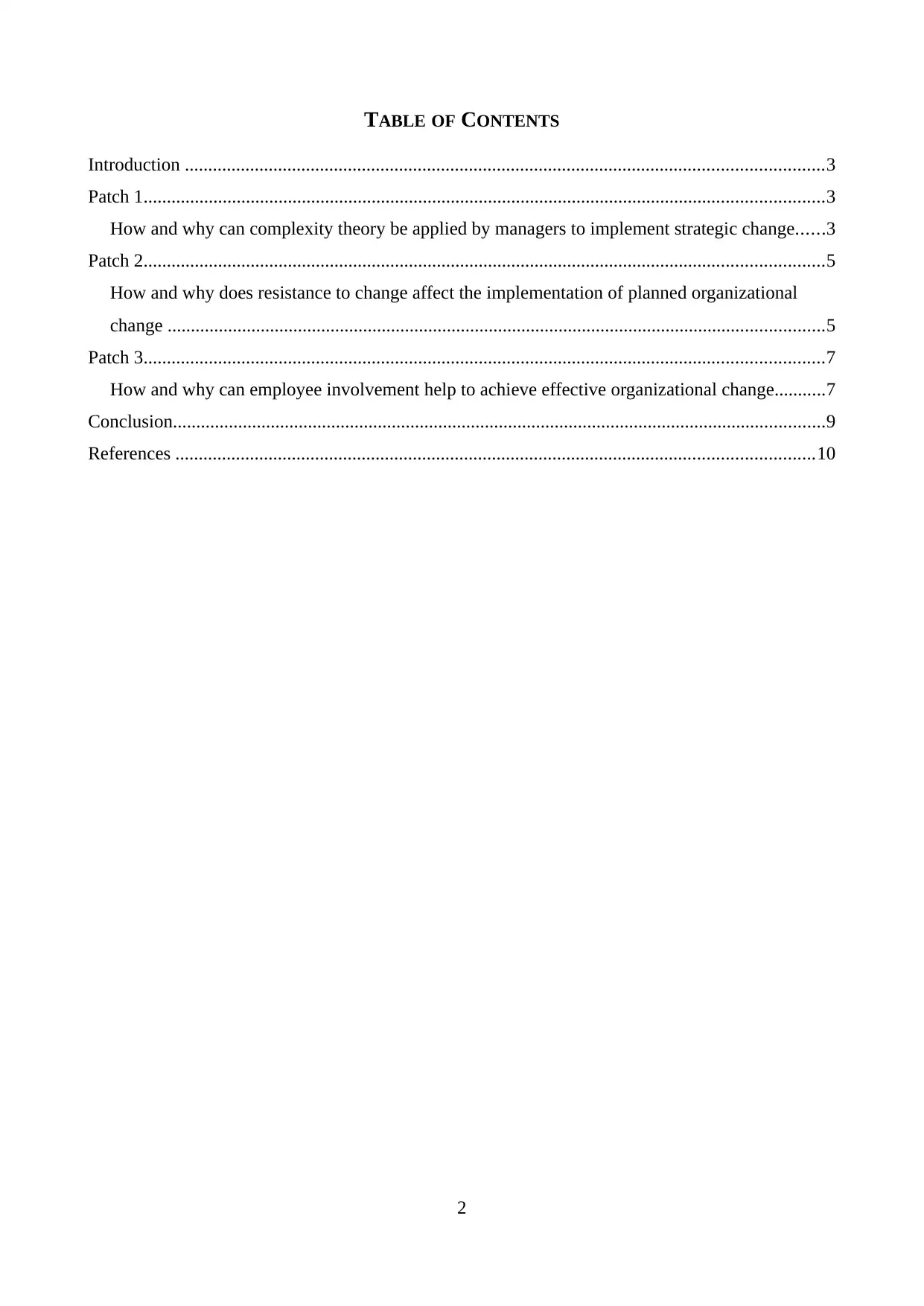
TABLE OF CONTENTS
Introduction .........................................................................................................................................3
Patch 1..................................................................................................................................................3
How and why can complexity theory be applied by managers to implement strategic change......3
Patch 2..................................................................................................................................................5
How and why does resistance to change affect the implementation of planned organizational
change .............................................................................................................................................5
Patch 3..................................................................................................................................................7
How and why can employee involvement help to achieve effective organizational change...........7
Conclusion............................................................................................................................................9
References .........................................................................................................................................10
2
Introduction .........................................................................................................................................3
Patch 1..................................................................................................................................................3
How and why can complexity theory be applied by managers to implement strategic change......3
Patch 2..................................................................................................................................................5
How and why does resistance to change affect the implementation of planned organizational
change .............................................................................................................................................5
Patch 3..................................................................................................................................................7
How and why can employee involvement help to achieve effective organizational change...........7
Conclusion............................................................................................................................................9
References .........................................................................................................................................10
2
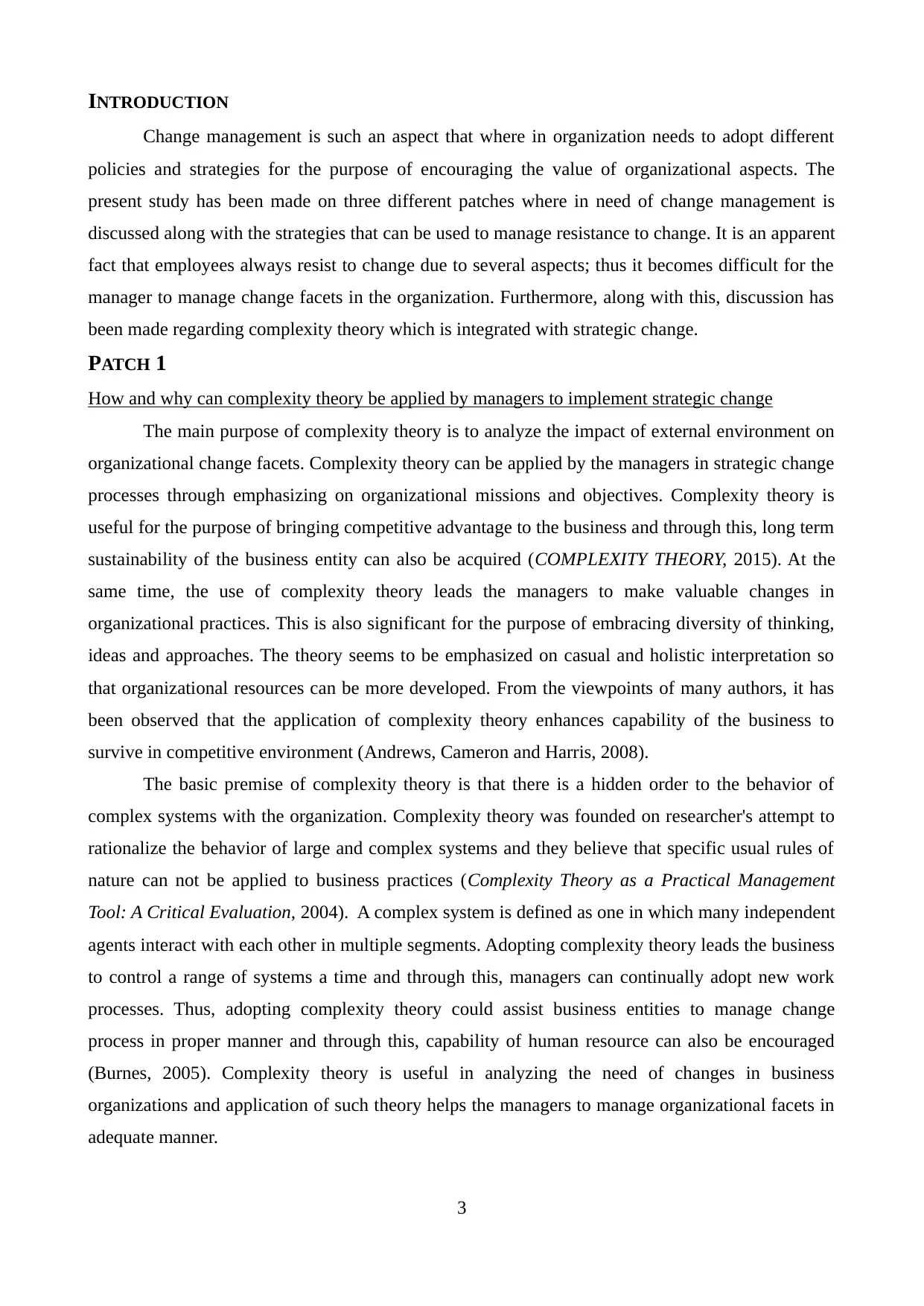
INTRODUCTION
Change management is such an aspect that where in organization needs to adopt different
policies and strategies for the purpose of encouraging the value of organizational aspects. The
present study has been made on three different patches where in need of change management is
discussed along with the strategies that can be used to manage resistance to change. It is an apparent
fact that employees always resist to change due to several aspects; thus it becomes difficult for the
manager to manage change facets in the organization. Furthermore, along with this, discussion has
been made regarding complexity theory which is integrated with strategic change.
PATCH 1
How and why can complexity theory be applied by managers to implement strategic change
The main purpose of complexity theory is to analyze the impact of external environment on
organizational change facets. Complexity theory can be applied by the managers in strategic change
processes through emphasizing on organizational missions and objectives. Complexity theory is
useful for the purpose of bringing competitive advantage to the business and through this, long term
sustainability of the business entity can also be acquired (COMPLEXITY THEORY, 2015). At the
same time, the use of complexity theory leads the managers to make valuable changes in
organizational practices. This is also significant for the purpose of embracing diversity of thinking,
ideas and approaches. The theory seems to be emphasized on casual and holistic interpretation so
that organizational resources can be more developed. From the viewpoints of many authors, it has
been observed that the application of complexity theory enhances capability of the business to
survive in competitive environment (Andrews, Cameron and Harris, 2008).
The basic premise of complexity theory is that there is a hidden order to the behavior of
complex systems with the organization. Complexity theory was founded on researcher's attempt to
rationalize the behavior of large and complex systems and they believe that specific usual rules of
nature can not be applied to business practices (Complexity Theory as a Practical Management
Tool: A Critical Evaluation, 2004). A complex system is defined as one in which many independent
agents interact with each other in multiple segments. Adopting complexity theory leads the business
to control a range of systems a time and through this, managers can continually adopt new work
processes. Thus, adopting complexity theory could assist business entities to manage change
process in proper manner and through this, capability of human resource can also be encouraged
(Burnes, 2005). Complexity theory is useful in analyzing the need of changes in business
organizations and application of such theory helps the managers to manage organizational facets in
adequate manner.
3
Change management is such an aspect that where in organization needs to adopt different
policies and strategies for the purpose of encouraging the value of organizational aspects. The
present study has been made on three different patches where in need of change management is
discussed along with the strategies that can be used to manage resistance to change. It is an apparent
fact that employees always resist to change due to several aspects; thus it becomes difficult for the
manager to manage change facets in the organization. Furthermore, along with this, discussion has
been made regarding complexity theory which is integrated with strategic change.
PATCH 1
How and why can complexity theory be applied by managers to implement strategic change
The main purpose of complexity theory is to analyze the impact of external environment on
organizational change facets. Complexity theory can be applied by the managers in strategic change
processes through emphasizing on organizational missions and objectives. Complexity theory is
useful for the purpose of bringing competitive advantage to the business and through this, long term
sustainability of the business entity can also be acquired (COMPLEXITY THEORY, 2015). At the
same time, the use of complexity theory leads the managers to make valuable changes in
organizational practices. This is also significant for the purpose of embracing diversity of thinking,
ideas and approaches. The theory seems to be emphasized on casual and holistic interpretation so
that organizational resources can be more developed. From the viewpoints of many authors, it has
been observed that the application of complexity theory enhances capability of the business to
survive in competitive environment (Andrews, Cameron and Harris, 2008).
The basic premise of complexity theory is that there is a hidden order to the behavior of
complex systems with the organization. Complexity theory was founded on researcher's attempt to
rationalize the behavior of large and complex systems and they believe that specific usual rules of
nature can not be applied to business practices (Complexity Theory as a Practical Management
Tool: A Critical Evaluation, 2004). A complex system is defined as one in which many independent
agents interact with each other in multiple segments. Adopting complexity theory leads the business
to control a range of systems a time and through this, managers can continually adopt new work
processes. Thus, adopting complexity theory could assist business entities to manage change
process in proper manner and through this, capability of human resource can also be encouraged
(Burnes, 2005). Complexity theory is useful in analyzing the need of changes in business
organizations and application of such theory helps the managers to manage organizational facets in
adequate manner.
3
⊘ This is a preview!⊘
Do you want full access?
Subscribe today to unlock all pages.

Trusted by 1+ million students worldwide
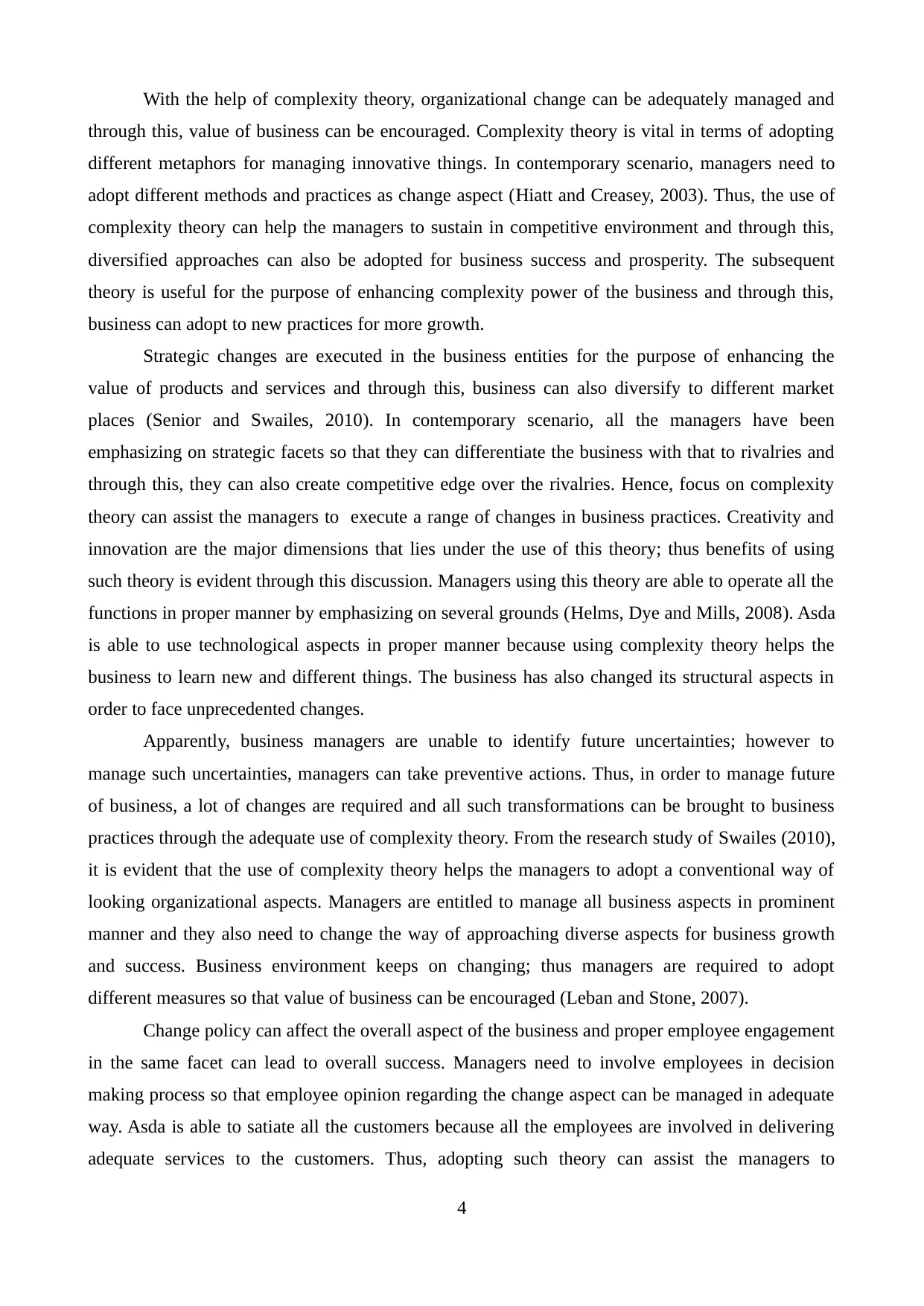
With the help of complexity theory, organizational change can be adequately managed and
through this, value of business can be encouraged. Complexity theory is vital in terms of adopting
different metaphors for managing innovative things. In contemporary scenario, managers need to
adopt different methods and practices as change aspect (Hiatt and Creasey, 2003). Thus, the use of
complexity theory can help the managers to sustain in competitive environment and through this,
diversified approaches can also be adopted for business success and prosperity. The subsequent
theory is useful for the purpose of enhancing complexity power of the business and through this,
business can adopt to new practices for more growth.
Strategic changes are executed in the business entities for the purpose of enhancing the
value of products and services and through this, business can also diversify to different market
places (Senior and Swailes, 2010). In contemporary scenario, all the managers have been
emphasizing on strategic facets so that they can differentiate the business with that to rivalries and
through this, they can also create competitive edge over the rivalries. Hence, focus on complexity
theory can assist the managers to execute a range of changes in business practices. Creativity and
innovation are the major dimensions that lies under the use of this theory; thus benefits of using
such theory is evident through this discussion. Managers using this theory are able to operate all the
functions in proper manner by emphasizing on several grounds (Helms, Dye and Mills, 2008). Asda
is able to use technological aspects in proper manner because using complexity theory helps the
business to learn new and different things. The business has also changed its structural aspects in
order to face unprecedented changes.
Apparently, business managers are unable to identify future uncertainties; however to
manage such uncertainties, managers can take preventive actions. Thus, in order to manage future
of business, a lot of changes are required and all such transformations can be brought to business
practices through the adequate use of complexity theory. From the research study of Swailes (2010),
it is evident that the use of complexity theory helps the managers to adopt a conventional way of
looking organizational aspects. Managers are entitled to manage all business aspects in prominent
manner and they also need to change the way of approaching diverse aspects for business growth
and success. Business environment keeps on changing; thus managers are required to adopt
different measures so that value of business can be encouraged (Leban and Stone, 2007).
Change policy can affect the overall aspect of the business and proper employee engagement
in the same facet can lead to overall success. Managers need to involve employees in decision
making process so that employee opinion regarding the change aspect can be managed in adequate
way. Asda is able to satiate all the customers because all the employees are involved in delivering
adequate services to the customers. Thus, adopting such theory can assist the managers to
4
through this, value of business can be encouraged. Complexity theory is vital in terms of adopting
different metaphors for managing innovative things. In contemporary scenario, managers need to
adopt different methods and practices as change aspect (Hiatt and Creasey, 2003). Thus, the use of
complexity theory can help the managers to sustain in competitive environment and through this,
diversified approaches can also be adopted for business success and prosperity. The subsequent
theory is useful for the purpose of enhancing complexity power of the business and through this,
business can adopt to new practices for more growth.
Strategic changes are executed in the business entities for the purpose of enhancing the
value of products and services and through this, business can also diversify to different market
places (Senior and Swailes, 2010). In contemporary scenario, all the managers have been
emphasizing on strategic facets so that they can differentiate the business with that to rivalries and
through this, they can also create competitive edge over the rivalries. Hence, focus on complexity
theory can assist the managers to execute a range of changes in business practices. Creativity and
innovation are the major dimensions that lies under the use of this theory; thus benefits of using
such theory is evident through this discussion. Managers using this theory are able to operate all the
functions in proper manner by emphasizing on several grounds (Helms, Dye and Mills, 2008). Asda
is able to use technological aspects in proper manner because using complexity theory helps the
business to learn new and different things. The business has also changed its structural aspects in
order to face unprecedented changes.
Apparently, business managers are unable to identify future uncertainties; however to
manage such uncertainties, managers can take preventive actions. Thus, in order to manage future
of business, a lot of changes are required and all such transformations can be brought to business
practices through the adequate use of complexity theory. From the research study of Swailes (2010),
it is evident that the use of complexity theory helps the managers to adopt a conventional way of
looking organizational aspects. Managers are entitled to manage all business aspects in prominent
manner and they also need to change the way of approaching diverse aspects for business growth
and success. Business environment keeps on changing; thus managers are required to adopt
different measures so that value of business can be encouraged (Leban and Stone, 2007).
Change policy can affect the overall aspect of the business and proper employee engagement
in the same facet can lead to overall success. Managers need to involve employees in decision
making process so that employee opinion regarding the change aspect can be managed in adequate
way. Asda is able to satiate all the customers because all the employees are involved in delivering
adequate services to the customers. Thus, adopting such theory can assist the managers to
4
Paraphrase This Document
Need a fresh take? Get an instant paraphrase of this document with our AI Paraphraser
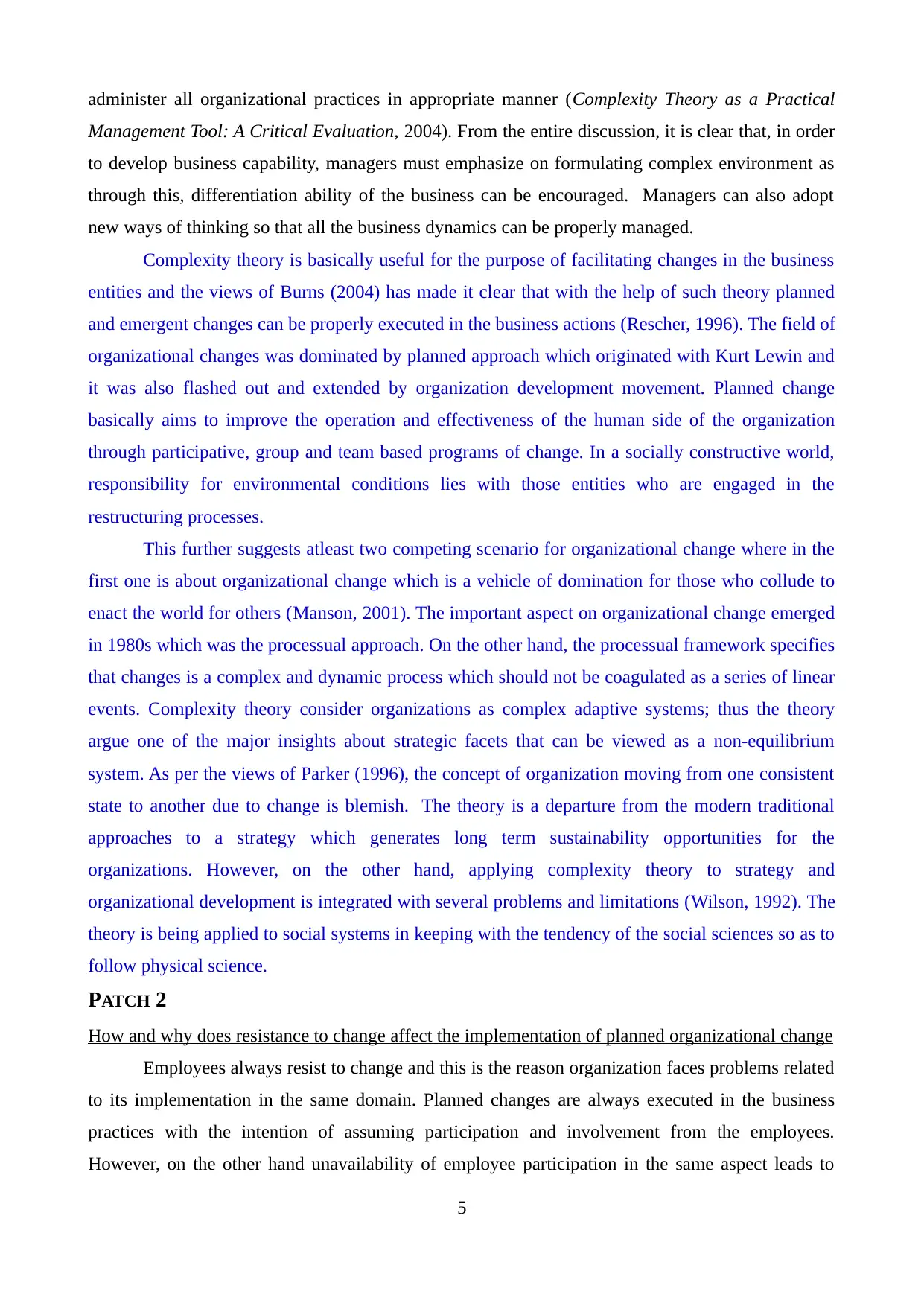
administer all organizational practices in appropriate manner (Complexity Theory as a Practical
Management Tool: A Critical Evaluation, 2004). From the entire discussion, it is clear that, in order
to develop business capability, managers must emphasize on formulating complex environment as
through this, differentiation ability of the business can be encouraged. Managers can also adopt
new ways of thinking so that all the business dynamics can be properly managed.
Complexity theory is basically useful for the purpose of facilitating changes in the business
entities and the views of Burns (2004) has made it clear that with the help of such theory planned
and emergent changes can be properly executed in the business actions (Rescher, 1996). The field of
organizational changes was dominated by planned approach which originated with Kurt Lewin and
it was also flashed out and extended by organization development movement. Planned change
basically aims to improve the operation and effectiveness of the human side of the organization
through participative, group and team based programs of change. In a socially constructive world,
responsibility for environmental conditions lies with those entities who are engaged in the
restructuring processes.
This further suggests atleast two competing scenario for organizational change where in the
first one is about organizational change which is a vehicle of domination for those who collude to
enact the world for others (Manson, 2001). The important aspect on organizational change emerged
in 1980s which was the processual approach. On the other hand, the processual framework specifies
that changes is a complex and dynamic process which should not be coagulated as a series of linear
events. Complexity theory consider organizations as complex adaptive systems; thus the theory
argue one of the major insights about strategic facets that can be viewed as a non-equilibrium
system. As per the views of Parker (1996), the concept of organization moving from one consistent
state to another due to change is blemish. The theory is a departure from the modern traditional
approaches to a strategy which generates long term sustainability opportunities for the
organizations. However, on the other hand, applying complexity theory to strategy and
organizational development is integrated with several problems and limitations (Wilson, 1992). The
theory is being applied to social systems in keeping with the tendency of the social sciences so as to
follow physical science.
PATCH 2
How and why does resistance to change affect the implementation of planned organizational change
Employees always resist to change and this is the reason organization faces problems related
to its implementation in the same domain. Planned changes are always executed in the business
practices with the intention of assuming participation and involvement from the employees.
However, on the other hand unavailability of employee participation in the same aspect leads to
5
Management Tool: A Critical Evaluation, 2004). From the entire discussion, it is clear that, in order
to develop business capability, managers must emphasize on formulating complex environment as
through this, differentiation ability of the business can be encouraged. Managers can also adopt
new ways of thinking so that all the business dynamics can be properly managed.
Complexity theory is basically useful for the purpose of facilitating changes in the business
entities and the views of Burns (2004) has made it clear that with the help of such theory planned
and emergent changes can be properly executed in the business actions (Rescher, 1996). The field of
organizational changes was dominated by planned approach which originated with Kurt Lewin and
it was also flashed out and extended by organization development movement. Planned change
basically aims to improve the operation and effectiveness of the human side of the organization
through participative, group and team based programs of change. In a socially constructive world,
responsibility for environmental conditions lies with those entities who are engaged in the
restructuring processes.
This further suggests atleast two competing scenario for organizational change where in the
first one is about organizational change which is a vehicle of domination for those who collude to
enact the world for others (Manson, 2001). The important aspect on organizational change emerged
in 1980s which was the processual approach. On the other hand, the processual framework specifies
that changes is a complex and dynamic process which should not be coagulated as a series of linear
events. Complexity theory consider organizations as complex adaptive systems; thus the theory
argue one of the major insights about strategic facets that can be viewed as a non-equilibrium
system. As per the views of Parker (1996), the concept of organization moving from one consistent
state to another due to change is blemish. The theory is a departure from the modern traditional
approaches to a strategy which generates long term sustainability opportunities for the
organizations. However, on the other hand, applying complexity theory to strategy and
organizational development is integrated with several problems and limitations (Wilson, 1992). The
theory is being applied to social systems in keeping with the tendency of the social sciences so as to
follow physical science.
PATCH 2
How and why does resistance to change affect the implementation of planned organizational change
Employees always resist to change and this is the reason organization faces problems related
to its implementation in the same domain. Planned changes are always executed in the business
practices with the intention of assuming participation and involvement from the employees.
However, on the other hand unavailability of employee participation in the same aspect leads to
5
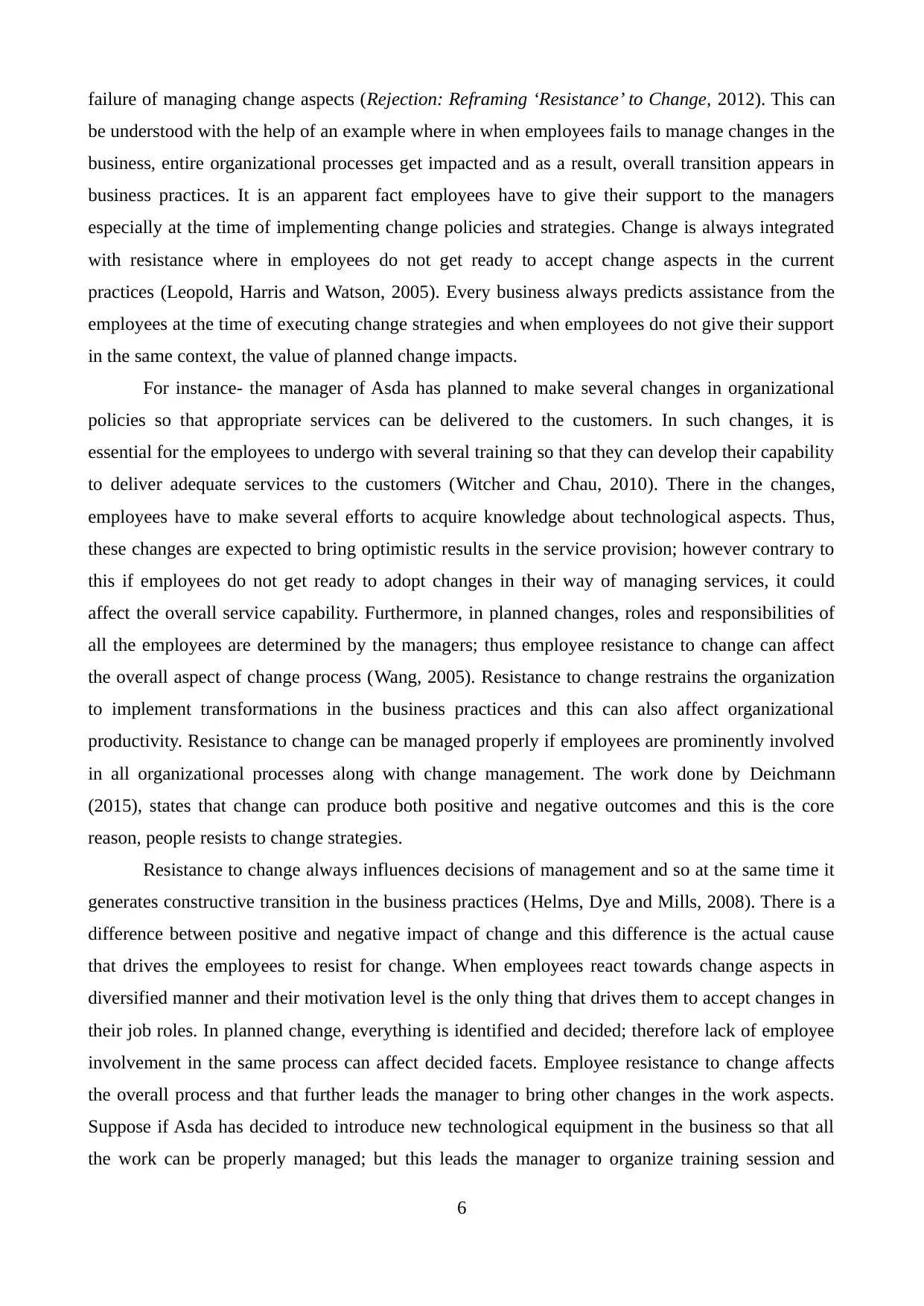
failure of managing change aspects (Rejection: Reframing ‘Resistance’ to Change, 2012). This can
be understood with the help of an example where in when employees fails to manage changes in the
business, entire organizational processes get impacted and as a result, overall transition appears in
business practices. It is an apparent fact employees have to give their support to the managers
especially at the time of implementing change policies and strategies. Change is always integrated
with resistance where in employees do not get ready to accept change aspects in the current
practices (Leopold, Harris and Watson, 2005). Every business always predicts assistance from the
employees at the time of executing change strategies and when employees do not give their support
in the same context, the value of planned change impacts.
For instance- the manager of Asda has planned to make several changes in organizational
policies so that appropriate services can be delivered to the customers. In such changes, it is
essential for the employees to undergo with several training so that they can develop their capability
to deliver adequate services to the customers (Witcher and Chau, 2010). There in the changes,
employees have to make several efforts to acquire knowledge about technological aspects. Thus,
these changes are expected to bring optimistic results in the service provision; however contrary to
this if employees do not get ready to adopt changes in their way of managing services, it could
affect the overall service capability. Furthermore, in planned changes, roles and responsibilities of
all the employees are determined by the managers; thus employee resistance to change can affect
the overall aspect of change process (Wang, 2005). Resistance to change restrains the organization
to implement transformations in the business practices and this can also affect organizational
productivity. Resistance to change can be managed properly if employees are prominently involved
in all organizational processes along with change management. The work done by Deichmann
(2015), states that change can produce both positive and negative outcomes and this is the core
reason, people resists to change strategies.
Resistance to change always influences decisions of management and so at the same time it
generates constructive transition in the business practices (Helms, Dye and Mills, 2008). There is a
difference between positive and negative impact of change and this difference is the actual cause
that drives the employees to resist for change. When employees react towards change aspects in
diversified manner and their motivation level is the only thing that drives them to accept changes in
their job roles. In planned change, everything is identified and decided; therefore lack of employee
involvement in the same process can affect decided facets. Employee resistance to change affects
the overall process and that further leads the manager to bring other changes in the work aspects.
Suppose if Asda has decided to introduce new technological equipment in the business so that all
the work can be properly managed; but this leads the manager to organize training session and
6
be understood with the help of an example where in when employees fails to manage changes in the
business, entire organizational processes get impacted and as a result, overall transition appears in
business practices. It is an apparent fact employees have to give their support to the managers
especially at the time of implementing change policies and strategies. Change is always integrated
with resistance where in employees do not get ready to accept change aspects in the current
practices (Leopold, Harris and Watson, 2005). Every business always predicts assistance from the
employees at the time of executing change strategies and when employees do not give their support
in the same context, the value of planned change impacts.
For instance- the manager of Asda has planned to make several changes in organizational
policies so that appropriate services can be delivered to the customers. In such changes, it is
essential for the employees to undergo with several training so that they can develop their capability
to deliver adequate services to the customers (Witcher and Chau, 2010). There in the changes,
employees have to make several efforts to acquire knowledge about technological aspects. Thus,
these changes are expected to bring optimistic results in the service provision; however contrary to
this if employees do not get ready to adopt changes in their way of managing services, it could
affect the overall service capability. Furthermore, in planned changes, roles and responsibilities of
all the employees are determined by the managers; thus employee resistance to change can affect
the overall aspect of change process (Wang, 2005). Resistance to change restrains the organization
to implement transformations in the business practices and this can also affect organizational
productivity. Resistance to change can be managed properly if employees are prominently involved
in all organizational processes along with change management. The work done by Deichmann
(2015), states that change can produce both positive and negative outcomes and this is the core
reason, people resists to change strategies.
Resistance to change always influences decisions of management and so at the same time it
generates constructive transition in the business practices (Helms, Dye and Mills, 2008). There is a
difference between positive and negative impact of change and this difference is the actual cause
that drives the employees to resist for change. When employees react towards change aspects in
diversified manner and their motivation level is the only thing that drives them to accept changes in
their job roles. In planned change, everything is identified and decided; therefore lack of employee
involvement in the same process can affect decided facets. Employee resistance to change affects
the overall process and that further leads the manager to bring other changes in the work aspects.
Suppose if Asda has decided to introduce new technological equipment in the business so that all
the work can be properly managed; but this leads the manager to organize training session and
6
⊘ This is a preview!⊘
Do you want full access?
Subscribe today to unlock all pages.

Trusted by 1+ million students worldwide
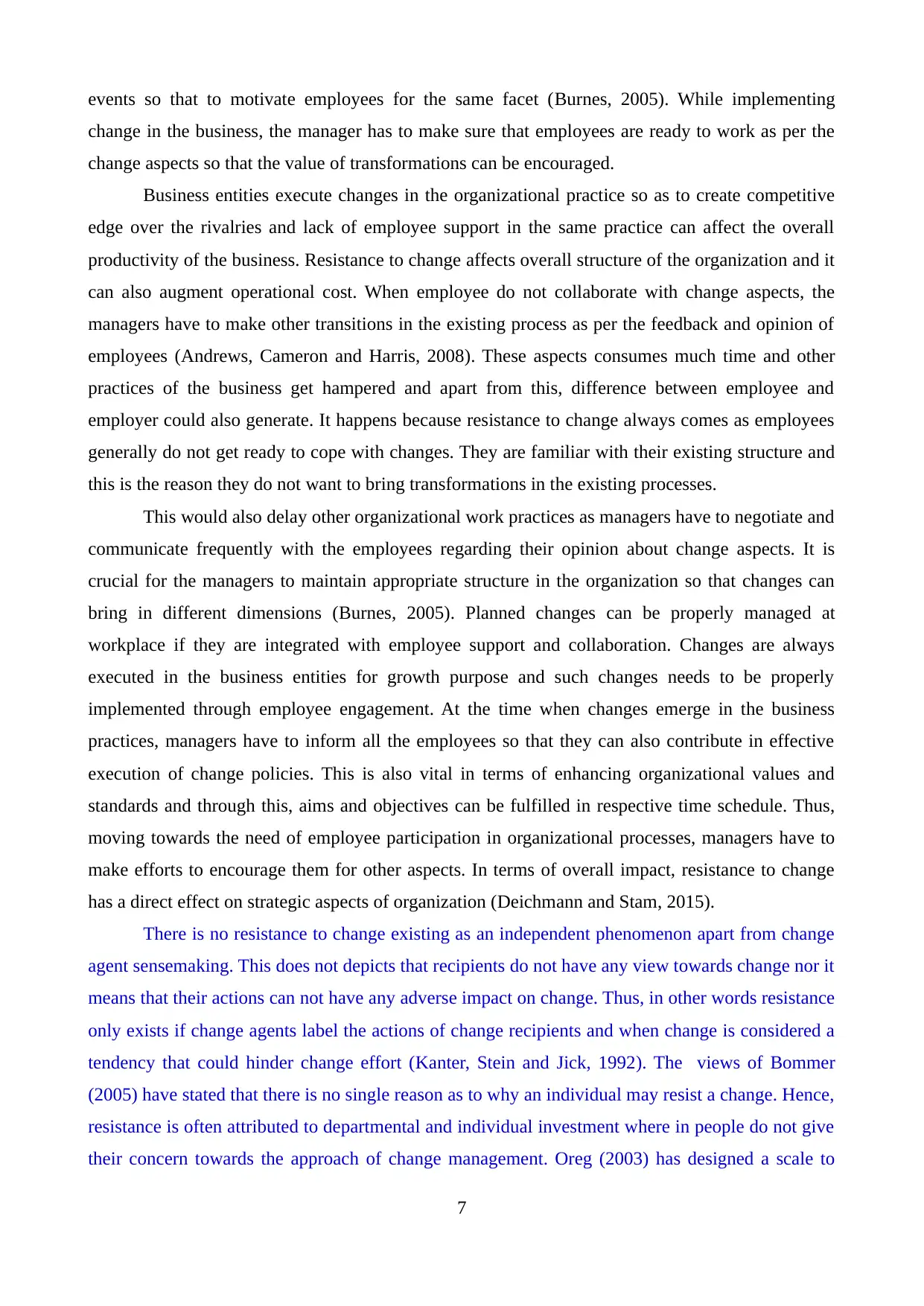
events so that to motivate employees for the same facet (Burnes, 2005). While implementing
change in the business, the manager has to make sure that employees are ready to work as per the
change aspects so that the value of transformations can be encouraged.
Business entities execute changes in the organizational practice so as to create competitive
edge over the rivalries and lack of employee support in the same practice can affect the overall
productivity of the business. Resistance to change affects overall structure of the organization and it
can also augment operational cost. When employee do not collaborate with change aspects, the
managers have to make other transitions in the existing process as per the feedback and opinion of
employees (Andrews, Cameron and Harris, 2008). These aspects consumes much time and other
practices of the business get hampered and apart from this, difference between employee and
employer could also generate. It happens because resistance to change always comes as employees
generally do not get ready to cope with changes. They are familiar with their existing structure and
this is the reason they do not want to bring transformations in the existing processes.
This would also delay other organizational work practices as managers have to negotiate and
communicate frequently with the employees regarding their opinion about change aspects. It is
crucial for the managers to maintain appropriate structure in the organization so that changes can
bring in different dimensions (Burnes, 2005). Planned changes can be properly managed at
workplace if they are integrated with employee support and collaboration. Changes are always
executed in the business entities for growth purpose and such changes needs to be properly
implemented through employee engagement. At the time when changes emerge in the business
practices, managers have to inform all the employees so that they can also contribute in effective
execution of change policies. This is also vital in terms of enhancing organizational values and
standards and through this, aims and objectives can be fulfilled in respective time schedule. Thus,
moving towards the need of employee participation in organizational processes, managers have to
make efforts to encourage them for other aspects. In terms of overall impact, resistance to change
has a direct effect on strategic aspects of organization (Deichmann and Stam, 2015).
There is no resistance to change existing as an independent phenomenon apart from change
agent sensemaking. This does not depicts that recipients do not have any view towards change nor it
means that their actions can not have any adverse impact on change. Thus, in other words resistance
only exists if change agents label the actions of change recipients and when change is considered a
tendency that could hinder change effort (Kanter, Stein and Jick, 1992). The views of Bommer
(2005) have stated that there is no single reason as to why an individual may resist a change. Hence,
resistance is often attributed to departmental and individual investment where in people do not give
their concern towards the approach of change management. Oreg (2003) has designed a scale to
7
change in the business, the manager has to make sure that employees are ready to work as per the
change aspects so that the value of transformations can be encouraged.
Business entities execute changes in the organizational practice so as to create competitive
edge over the rivalries and lack of employee support in the same practice can affect the overall
productivity of the business. Resistance to change affects overall structure of the organization and it
can also augment operational cost. When employee do not collaborate with change aspects, the
managers have to make other transitions in the existing process as per the feedback and opinion of
employees (Andrews, Cameron and Harris, 2008). These aspects consumes much time and other
practices of the business get hampered and apart from this, difference between employee and
employer could also generate. It happens because resistance to change always comes as employees
generally do not get ready to cope with changes. They are familiar with their existing structure and
this is the reason they do not want to bring transformations in the existing processes.
This would also delay other organizational work practices as managers have to negotiate and
communicate frequently with the employees regarding their opinion about change aspects. It is
crucial for the managers to maintain appropriate structure in the organization so that changes can
bring in different dimensions (Burnes, 2005). Planned changes can be properly managed at
workplace if they are integrated with employee support and collaboration. Changes are always
executed in the business entities for growth purpose and such changes needs to be properly
implemented through employee engagement. At the time when changes emerge in the business
practices, managers have to inform all the employees so that they can also contribute in effective
execution of change policies. This is also vital in terms of enhancing organizational values and
standards and through this, aims and objectives can be fulfilled in respective time schedule. Thus,
moving towards the need of employee participation in organizational processes, managers have to
make efforts to encourage them for other aspects. In terms of overall impact, resistance to change
has a direct effect on strategic aspects of organization (Deichmann and Stam, 2015).
There is no resistance to change existing as an independent phenomenon apart from change
agent sensemaking. This does not depicts that recipients do not have any view towards change nor it
means that their actions can not have any adverse impact on change. Thus, in other words resistance
only exists if change agents label the actions of change recipients and when change is considered a
tendency that could hinder change effort (Kanter, Stein and Jick, 1992). The views of Bommer
(2005) have stated that there is no single reason as to why an individual may resist a change. Hence,
resistance is often attributed to departmental and individual investment where in people do not give
their concern towards the approach of change management. Oreg (2003) has designed a scale to
7
Paraphrase This Document
Need a fresh take? Get an instant paraphrase of this document with our AI Paraphraser
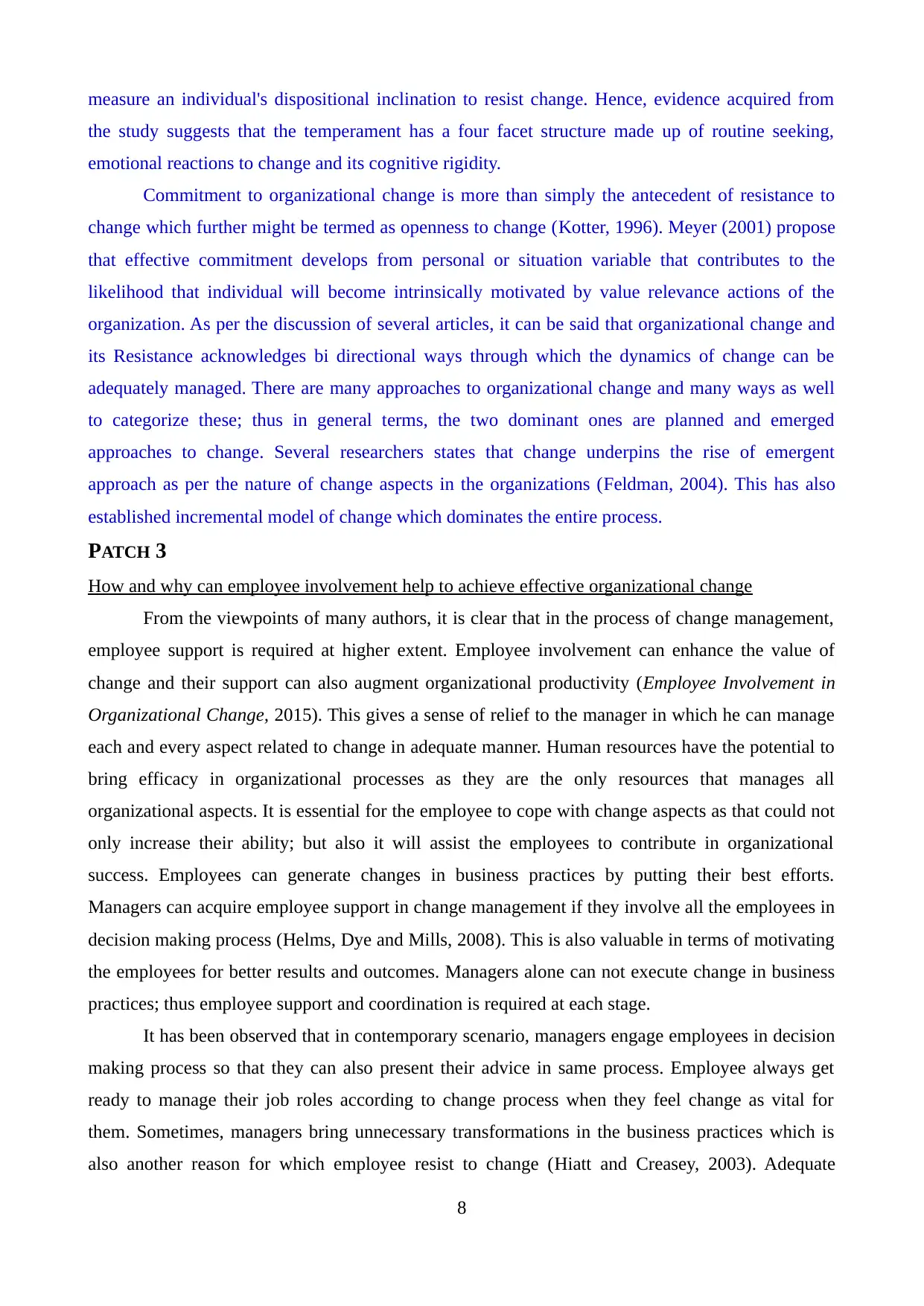
measure an individual's dispositional inclination to resist change. Hence, evidence acquired from
the study suggests that the temperament has a four facet structure made up of routine seeking,
emotional reactions to change and its cognitive rigidity.
Commitment to organizational change is more than simply the antecedent of resistance to
change which further might be termed as openness to change (Kotter, 1996). Meyer (2001) propose
that effective commitment develops from personal or situation variable that contributes to the
likelihood that individual will become intrinsically motivated by value relevance actions of the
organization. As per the discussion of several articles, it can be said that organizational change and
its Resistance acknowledges bi directional ways through which the dynamics of change can be
adequately managed. There are many approaches to organizational change and many ways as well
to categorize these; thus in general terms, the two dominant ones are planned and emerged
approaches to change. Several researchers states that change underpins the rise of emergent
approach as per the nature of change aspects in the organizations (Feldman, 2004). This has also
established incremental model of change which dominates the entire process.
PATCH 3
How and why can employee involvement help to achieve effective organizational change
From the viewpoints of many authors, it is clear that in the process of change management,
employee support is required at higher extent. Employee involvement can enhance the value of
change and their support can also augment organizational productivity (Employee Involvement in
Organizational Change, 2015). This gives a sense of relief to the manager in which he can manage
each and every aspect related to change in adequate manner. Human resources have the potential to
bring efficacy in organizational processes as they are the only resources that manages all
organizational aspects. It is essential for the employee to cope with change aspects as that could not
only increase their ability; but also it will assist the employees to contribute in organizational
success. Employees can generate changes in business practices by putting their best efforts.
Managers can acquire employee support in change management if they involve all the employees in
decision making process (Helms, Dye and Mills, 2008). This is also valuable in terms of motivating
the employees for better results and outcomes. Managers alone can not execute change in business
practices; thus employee support and coordination is required at each stage.
It has been observed that in contemporary scenario, managers engage employees in decision
making process so that they can also present their advice in same process. Employee always get
ready to manage their job roles according to change process when they feel change as vital for
them. Sometimes, managers bring unnecessary transformations in the business practices which is
also another reason for which employee resist to change (Hiatt and Creasey, 2003). Adequate
8
the study suggests that the temperament has a four facet structure made up of routine seeking,
emotional reactions to change and its cognitive rigidity.
Commitment to organizational change is more than simply the antecedent of resistance to
change which further might be termed as openness to change (Kotter, 1996). Meyer (2001) propose
that effective commitment develops from personal or situation variable that contributes to the
likelihood that individual will become intrinsically motivated by value relevance actions of the
organization. As per the discussion of several articles, it can be said that organizational change and
its Resistance acknowledges bi directional ways through which the dynamics of change can be
adequately managed. There are many approaches to organizational change and many ways as well
to categorize these; thus in general terms, the two dominant ones are planned and emerged
approaches to change. Several researchers states that change underpins the rise of emergent
approach as per the nature of change aspects in the organizations (Feldman, 2004). This has also
established incremental model of change which dominates the entire process.
PATCH 3
How and why can employee involvement help to achieve effective organizational change
From the viewpoints of many authors, it is clear that in the process of change management,
employee support is required at higher extent. Employee involvement can enhance the value of
change and their support can also augment organizational productivity (Employee Involvement in
Organizational Change, 2015). This gives a sense of relief to the manager in which he can manage
each and every aspect related to change in adequate manner. Human resources have the potential to
bring efficacy in organizational processes as they are the only resources that manages all
organizational aspects. It is essential for the employee to cope with change aspects as that could not
only increase their ability; but also it will assist the employees to contribute in organizational
success. Employees can generate changes in business practices by putting their best efforts.
Managers can acquire employee support in change management if they involve all the employees in
decision making process (Helms, Dye and Mills, 2008). This is also valuable in terms of motivating
the employees for better results and outcomes. Managers alone can not execute change in business
practices; thus employee support and coordination is required at each stage.
It has been observed that in contemporary scenario, managers engage employees in decision
making process so that they can also present their advice in same process. Employee always get
ready to manage their job roles according to change process when they feel change as vital for
them. Sometimes, managers bring unnecessary transformations in the business practices which is
also another reason for which employee resist to change (Hiatt and Creasey, 2003). Adequate
8
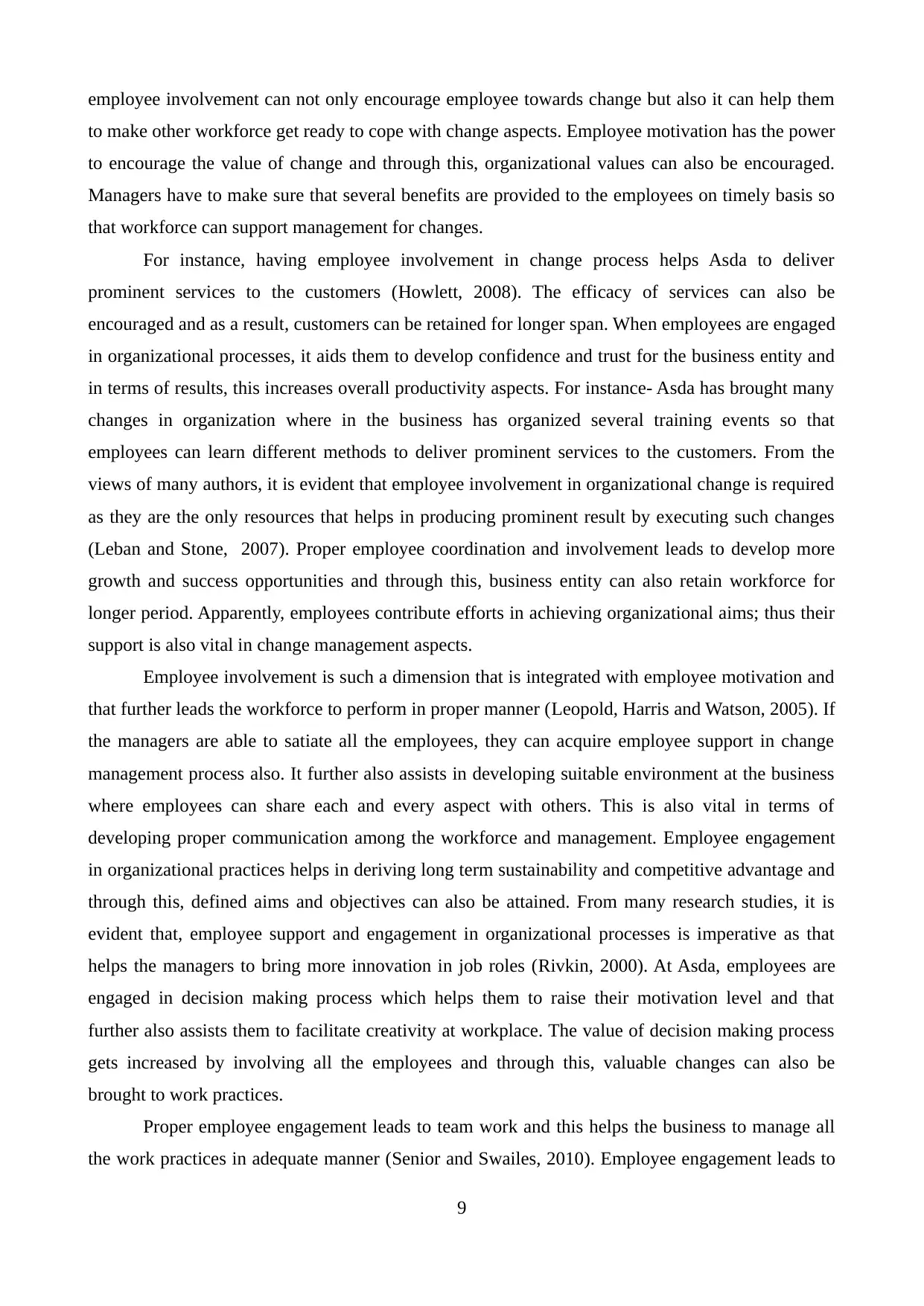
employee involvement can not only encourage employee towards change but also it can help them
to make other workforce get ready to cope with change aspects. Employee motivation has the power
to encourage the value of change and through this, organizational values can also be encouraged.
Managers have to make sure that several benefits are provided to the employees on timely basis so
that workforce can support management for changes.
For instance, having employee involvement in change process helps Asda to deliver
prominent services to the customers (Howlett, 2008). The efficacy of services can also be
encouraged and as a result, customers can be retained for longer span. When employees are engaged
in organizational processes, it aids them to develop confidence and trust for the business entity and
in terms of results, this increases overall productivity aspects. For instance- Asda has brought many
changes in organization where in the business has organized several training events so that
employees can learn different methods to deliver prominent services to the customers. From the
views of many authors, it is evident that employee involvement in organizational change is required
as they are the only resources that helps in producing prominent result by executing such changes
(Leban and Stone, 2007). Proper employee coordination and involvement leads to develop more
growth and success opportunities and through this, business entity can also retain workforce for
longer period. Apparently, employees contribute efforts in achieving organizational aims; thus their
support is also vital in change management aspects.
Employee involvement is such a dimension that is integrated with employee motivation and
that further leads the workforce to perform in proper manner (Leopold, Harris and Watson, 2005). If
the managers are able to satiate all the employees, they can acquire employee support in change
management process also. It further also assists in developing suitable environment at the business
where employees can share each and every aspect with others. This is also vital in terms of
developing proper communication among the workforce and management. Employee engagement
in organizational practices helps in deriving long term sustainability and competitive advantage and
through this, defined aims and objectives can also be attained. From many research studies, it is
evident that, employee support and engagement in organizational processes is imperative as that
helps the managers to bring more innovation in job roles (Rivkin, 2000). At Asda, employees are
engaged in decision making process which helps them to raise their motivation level and that
further also assists them to facilitate creativity at workplace. The value of decision making process
gets increased by involving all the employees and through this, valuable changes can also be
brought to work practices.
Proper employee engagement leads to team work and this helps the business to manage all
the work practices in adequate manner (Senior and Swailes, 2010). Employee engagement leads to
9
to make other workforce get ready to cope with change aspects. Employee motivation has the power
to encourage the value of change and through this, organizational values can also be encouraged.
Managers have to make sure that several benefits are provided to the employees on timely basis so
that workforce can support management for changes.
For instance, having employee involvement in change process helps Asda to deliver
prominent services to the customers (Howlett, 2008). The efficacy of services can also be
encouraged and as a result, customers can be retained for longer span. When employees are engaged
in organizational processes, it aids them to develop confidence and trust for the business entity and
in terms of results, this increases overall productivity aspects. For instance- Asda has brought many
changes in organization where in the business has organized several training events so that
employees can learn different methods to deliver prominent services to the customers. From the
views of many authors, it is evident that employee involvement in organizational change is required
as they are the only resources that helps in producing prominent result by executing such changes
(Leban and Stone, 2007). Proper employee coordination and involvement leads to develop more
growth and success opportunities and through this, business entity can also retain workforce for
longer period. Apparently, employees contribute efforts in achieving organizational aims; thus their
support is also vital in change management aspects.
Employee involvement is such a dimension that is integrated with employee motivation and
that further leads the workforce to perform in proper manner (Leopold, Harris and Watson, 2005). If
the managers are able to satiate all the employees, they can acquire employee support in change
management process also. It further also assists in developing suitable environment at the business
where employees can share each and every aspect with others. This is also vital in terms of
developing proper communication among the workforce and management. Employee engagement
in organizational practices helps in deriving long term sustainability and competitive advantage and
through this, defined aims and objectives can also be attained. From many research studies, it is
evident that, employee support and engagement in organizational processes is imperative as that
helps the managers to bring more innovation in job roles (Rivkin, 2000). At Asda, employees are
engaged in decision making process which helps them to raise their motivation level and that
further also assists them to facilitate creativity at workplace. The value of decision making process
gets increased by involving all the employees and through this, valuable changes can also be
brought to work practices.
Proper employee engagement leads to team work and this helps the business to manage all
the work practices in adequate manner (Senior and Swailes, 2010). Employee engagement leads to
9
⊘ This is a preview!⊘
Do you want full access?
Subscribe today to unlock all pages.

Trusted by 1+ million students worldwide
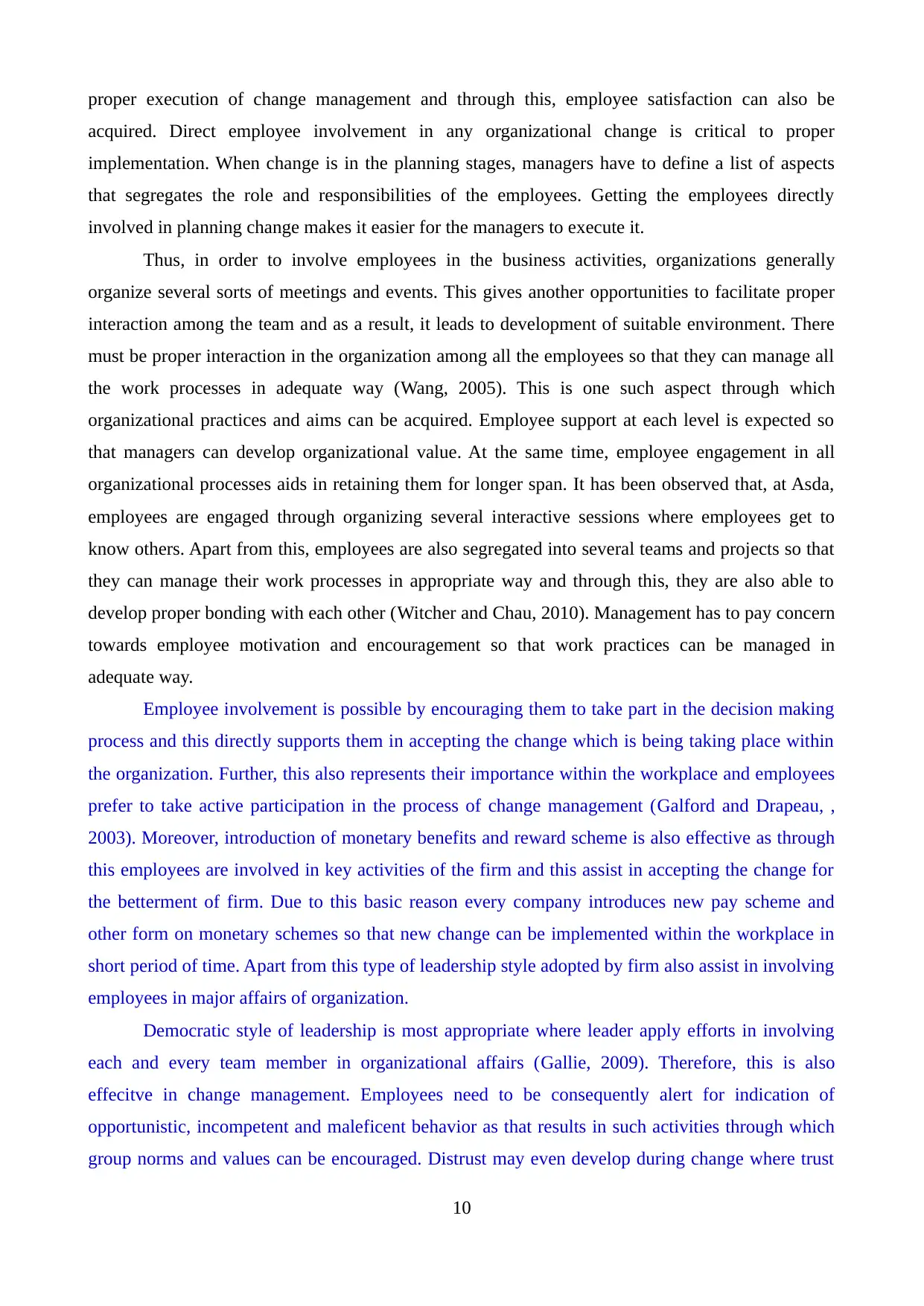
proper execution of change management and through this, employee satisfaction can also be
acquired. Direct employee involvement in any organizational change is critical to proper
implementation. When change is in the planning stages, managers have to define a list of aspects
that segregates the role and responsibilities of the employees. Getting the employees directly
involved in planning change makes it easier for the managers to execute it.
Thus, in order to involve employees in the business activities, organizations generally
organize several sorts of meetings and events. This gives another opportunities to facilitate proper
interaction among the team and as a result, it leads to development of suitable environment. There
must be proper interaction in the organization among all the employees so that they can manage all
the work processes in adequate way (Wang, 2005). This is one such aspect through which
organizational practices and aims can be acquired. Employee support at each level is expected so
that managers can develop organizational value. At the same time, employee engagement in all
organizational processes aids in retaining them for longer span. It has been observed that, at Asda,
employees are engaged through organizing several interactive sessions where employees get to
know others. Apart from this, employees are also segregated into several teams and projects so that
they can manage their work processes in appropriate way and through this, they are also able to
develop proper bonding with each other (Witcher and Chau, 2010). Management has to pay concern
towards employee motivation and encouragement so that work practices can be managed in
adequate way.
Employee involvement is possible by encouraging them to take part in the decision making
process and this directly supports them in accepting the change which is being taking place within
the organization. Further, this also represents their importance within the workplace and employees
prefer to take active participation in the process of change management (Galford and Drapeau, ,
2003). Moreover, introduction of monetary benefits and reward scheme is also effective as through
this employees are involved in key activities of the firm and this assist in accepting the change for
the betterment of firm. Due to this basic reason every company introduces new pay scheme and
other form on monetary schemes so that new change can be implemented within the workplace in
short period of time. Apart from this type of leadership style adopted by firm also assist in involving
employees in major affairs of organization.
Democratic style of leadership is most appropriate where leader apply efforts in involving
each and every team member in organizational affairs (Gallie, 2009). Therefore, this is also
effecitve in change management. Employees need to be consequently alert for indication of
opportunistic, incompetent and maleficent behavior as that results in such activities through which
group norms and values can be encouraged. Distrust may even develop during change where trust
10
acquired. Direct employee involvement in any organizational change is critical to proper
implementation. When change is in the planning stages, managers have to define a list of aspects
that segregates the role and responsibilities of the employees. Getting the employees directly
involved in planning change makes it easier for the managers to execute it.
Thus, in order to involve employees in the business activities, organizations generally
organize several sorts of meetings and events. This gives another opportunities to facilitate proper
interaction among the team and as a result, it leads to development of suitable environment. There
must be proper interaction in the organization among all the employees so that they can manage all
the work processes in adequate way (Wang, 2005). This is one such aspect through which
organizational practices and aims can be acquired. Employee support at each level is expected so
that managers can develop organizational value. At the same time, employee engagement in all
organizational processes aids in retaining them for longer span. It has been observed that, at Asda,
employees are engaged through organizing several interactive sessions where employees get to
know others. Apart from this, employees are also segregated into several teams and projects so that
they can manage their work processes in appropriate way and through this, they are also able to
develop proper bonding with each other (Witcher and Chau, 2010). Management has to pay concern
towards employee motivation and encouragement so that work practices can be managed in
adequate way.
Employee involvement is possible by encouraging them to take part in the decision making
process and this directly supports them in accepting the change which is being taking place within
the organization. Further, this also represents their importance within the workplace and employees
prefer to take active participation in the process of change management (Galford and Drapeau, ,
2003). Moreover, introduction of monetary benefits and reward scheme is also effective as through
this employees are involved in key activities of the firm and this assist in accepting the change for
the betterment of firm. Due to this basic reason every company introduces new pay scheme and
other form on monetary schemes so that new change can be implemented within the workplace in
short period of time. Apart from this type of leadership style adopted by firm also assist in involving
employees in major affairs of organization.
Democratic style of leadership is most appropriate where leader apply efforts in involving
each and every team member in organizational affairs (Gallie, 2009). Therefore, this is also
effecitve in change management. Employees need to be consequently alert for indication of
opportunistic, incompetent and maleficent behavior as that results in such activities through which
group norms and values can be encouraged. Distrust may even develop during change where trust
10
Paraphrase This Document
Need a fresh take? Get an instant paraphrase of this document with our AI Paraphraser
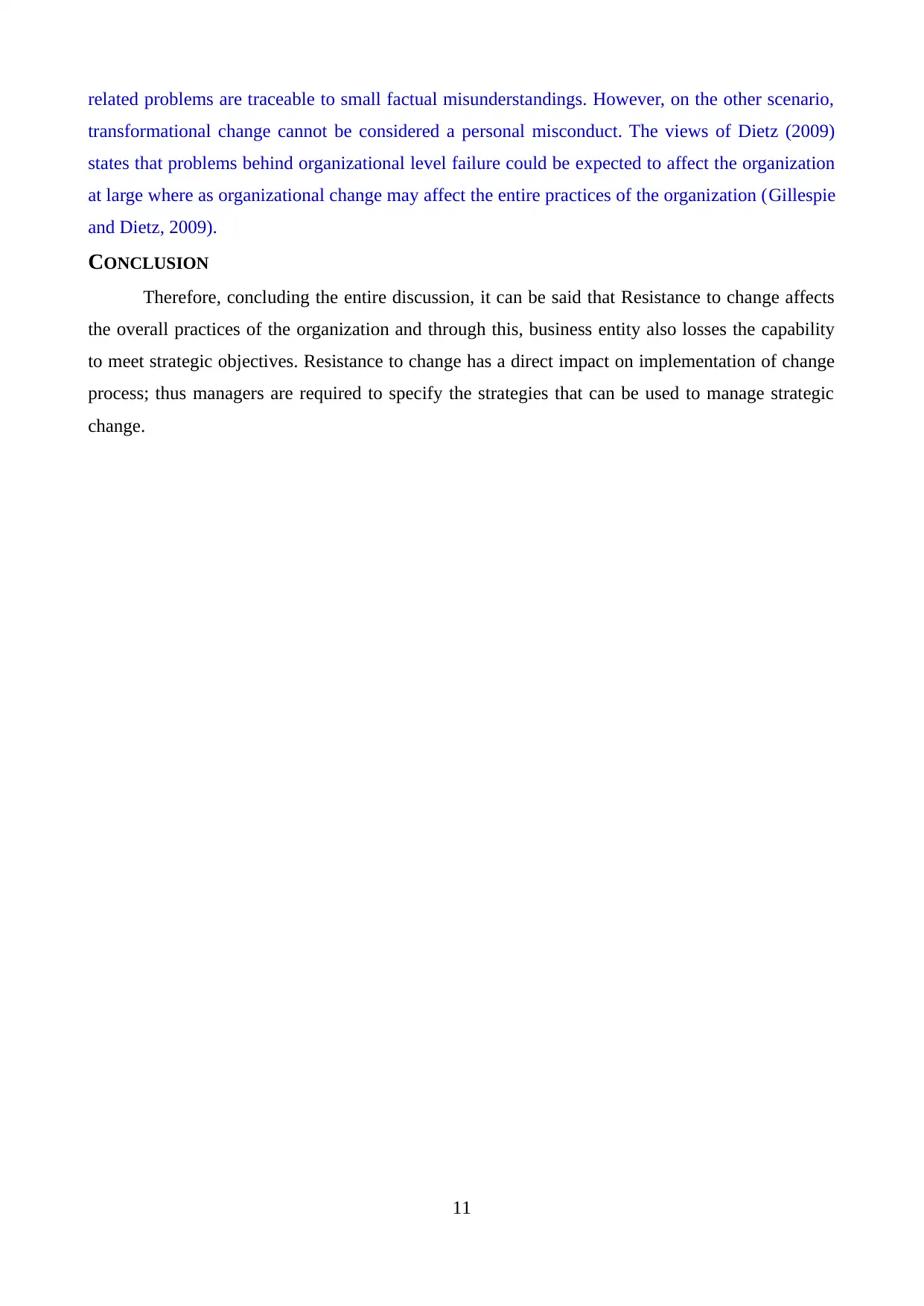
related problems are traceable to small factual misunderstandings. However, on the other scenario,
transformational change cannot be considered a personal misconduct. The views of Dietz (2009)
states that problems behind organizational level failure could be expected to affect the organization
at large where as organizational change may affect the entire practices of the organization (Gillespie
and Dietz, 2009).
CONCLUSION
Therefore, concluding the entire discussion, it can be said that Resistance to change affects
the overall practices of the organization and through this, business entity also losses the capability
to meet strategic objectives. Resistance to change has a direct impact on implementation of change
process; thus managers are required to specify the strategies that can be used to manage strategic
change.
11
transformational change cannot be considered a personal misconduct. The views of Dietz (2009)
states that problems behind organizational level failure could be expected to affect the organization
at large where as organizational change may affect the entire practices of the organization (Gillespie
and Dietz, 2009).
CONCLUSION
Therefore, concluding the entire discussion, it can be said that Resistance to change affects
the overall practices of the organization and through this, business entity also losses the capability
to meet strategic objectives. Resistance to change has a direct impact on implementation of change
process; thus managers are required to specify the strategies that can be used to manage strategic
change.
11
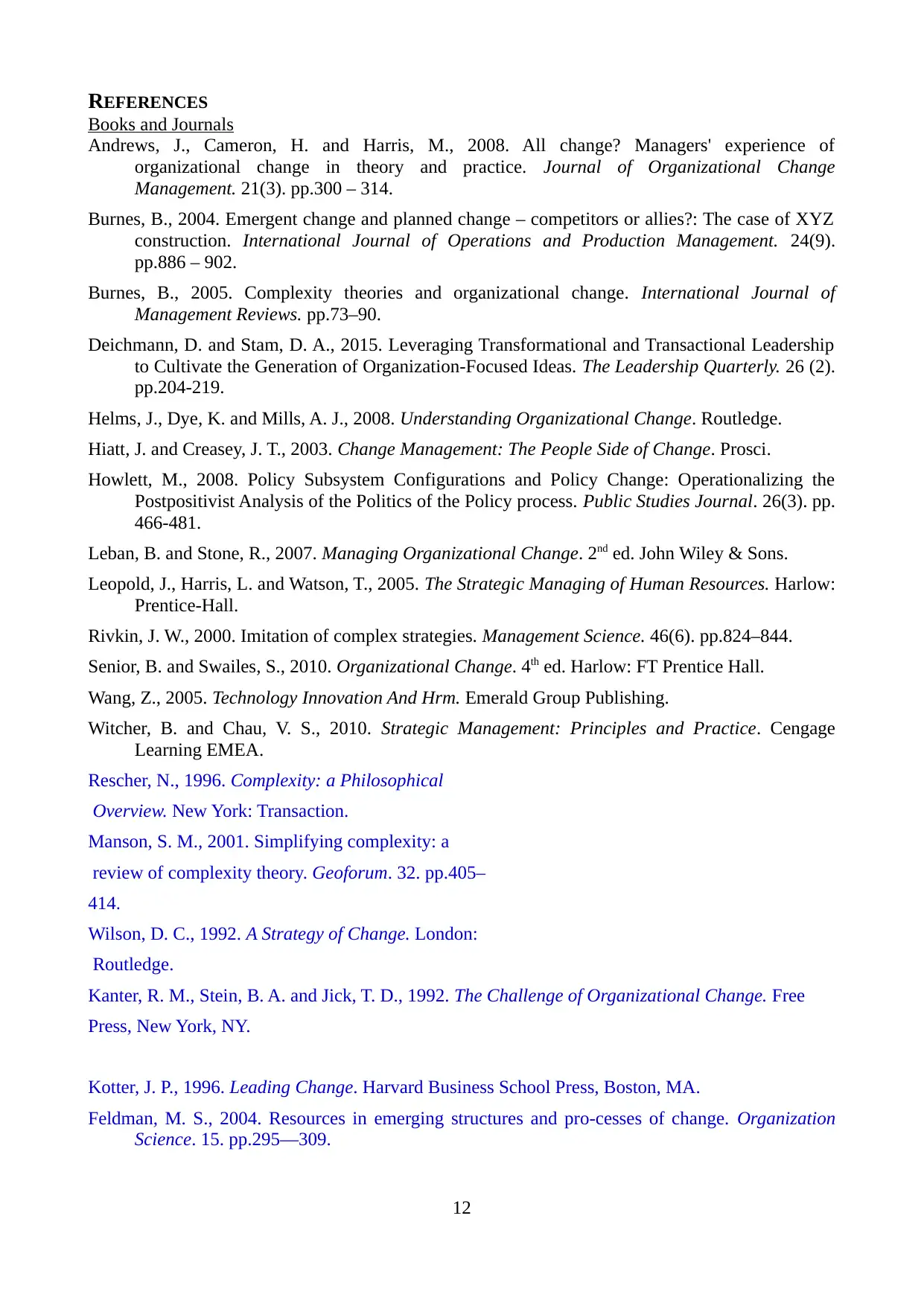
REFERENCES
Books and Journals
Andrews, J., Cameron, H. and Harris, M., 2008. All change? Managers' experience of
organizational change in theory and practice. Journal of Organizational Change
Management. 21(3). pp.300 – 314.
Burnes, B., 2004. Emergent change and planned change – competitors or allies?: The case of XYZ
construction. International Journal of Operations and Production Management. 24(9).
pp.886 – 902.
Burnes, B., 2005. Complexity theories and organizational change. International Journal of
Management Reviews. pp.73–90.
Deichmann, D. and Stam, D. A., 2015. Leveraging Transformational and Transactional Leadership
to Cultivate the Generation of Organization-Focused Ideas. The Leadership Quarterly. 26 (2).
pp.204-219.
Helms, J., Dye, K. and Mills, A. J., 2008. Understanding Organizational Change. Routledge.
Hiatt, J. and Creasey, J. T., 2003. Change Management: The People Side of Change. Prosci.
Howlett, M., 2008. Policy Subsystem Configurations and Policy Change: Operationalizing the
Postpositivist Analysis of the Politics of the Policy process. Public Studies Journal. 26(3). pp.
466-481.
Leban, B. and Stone, R., 2007. Managing Organizational Change. 2nd ed. John Wiley & Sons.
Leopold, J., Harris, L. and Watson, T., 2005. The Strategic Managing of Human Resources. Harlow:
Prentice-Hall.
Rivkin, J. W., 2000. Imitation of complex strategies. Management Science. 46(6). pp.824–844.
Senior, B. and Swailes, S., 2010. Organizational Change. 4th ed. Harlow: FT Prentice Hall.
Wang, Z., 2005. Technology Innovation And Hrm. Emerald Group Publishing.
Witcher, B. and Chau, V. S., 2010. Strategic Management: Principles and Practice. Cengage
Learning EMEA.
Rescher, N., 1996. Complexity: a Philosophical
Overview. New York: Transaction.
Manson, S. M., 2001. Simplifying complexity: a
review of complexity theory. Geoforum. 32. pp.405–
414.
Wilson, D. C., 1992. A Strategy of Change. London:
Routledge.
Kanter, R. M., Stein, B. A. and Jick, T. D., 1992. The Challenge of Organizational Change. Free
Press, New York, NY.
Kotter, J. P., 1996. Leading Change. Harvard Business School Press, Boston, MA.
Feldman, M. S., 2004. Resources in emerging structures and pro-cesses of change. Organization
Science. 15. pp.295—309.
12
Books and Journals
Andrews, J., Cameron, H. and Harris, M., 2008. All change? Managers' experience of
organizational change in theory and practice. Journal of Organizational Change
Management. 21(3). pp.300 – 314.
Burnes, B., 2004. Emergent change and planned change – competitors or allies?: The case of XYZ
construction. International Journal of Operations and Production Management. 24(9).
pp.886 – 902.
Burnes, B., 2005. Complexity theories and organizational change. International Journal of
Management Reviews. pp.73–90.
Deichmann, D. and Stam, D. A., 2015. Leveraging Transformational and Transactional Leadership
to Cultivate the Generation of Organization-Focused Ideas. The Leadership Quarterly. 26 (2).
pp.204-219.
Helms, J., Dye, K. and Mills, A. J., 2008. Understanding Organizational Change. Routledge.
Hiatt, J. and Creasey, J. T., 2003. Change Management: The People Side of Change. Prosci.
Howlett, M., 2008. Policy Subsystem Configurations and Policy Change: Operationalizing the
Postpositivist Analysis of the Politics of the Policy process. Public Studies Journal. 26(3). pp.
466-481.
Leban, B. and Stone, R., 2007. Managing Organizational Change. 2nd ed. John Wiley & Sons.
Leopold, J., Harris, L. and Watson, T., 2005. The Strategic Managing of Human Resources. Harlow:
Prentice-Hall.
Rivkin, J. W., 2000. Imitation of complex strategies. Management Science. 46(6). pp.824–844.
Senior, B. and Swailes, S., 2010. Organizational Change. 4th ed. Harlow: FT Prentice Hall.
Wang, Z., 2005. Technology Innovation And Hrm. Emerald Group Publishing.
Witcher, B. and Chau, V. S., 2010. Strategic Management: Principles and Practice. Cengage
Learning EMEA.
Rescher, N., 1996. Complexity: a Philosophical
Overview. New York: Transaction.
Manson, S. M., 2001. Simplifying complexity: a
review of complexity theory. Geoforum. 32. pp.405–
414.
Wilson, D. C., 1992. A Strategy of Change. London:
Routledge.
Kanter, R. M., Stein, B. A. and Jick, T. D., 1992. The Challenge of Organizational Change. Free
Press, New York, NY.
Kotter, J. P., 1996. Leading Change. Harvard Business School Press, Boston, MA.
Feldman, M. S., 2004. Resources in emerging structures and pro-cesses of change. Organization
Science. 15. pp.295—309.
12
⊘ This is a preview!⊘
Do you want full access?
Subscribe today to unlock all pages.

Trusted by 1+ million students worldwide
1 out of 13
Related Documents
Your All-in-One AI-Powered Toolkit for Academic Success.
+13062052269
info@desklib.com
Available 24*7 on WhatsApp / Email
![[object Object]](/_next/static/media/star-bottom.7253800d.svg)
Unlock your academic potential
Copyright © 2020–2025 A2Z Services. All Rights Reserved. Developed and managed by ZUCOL.




